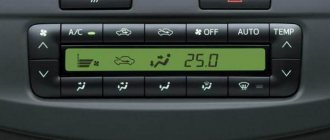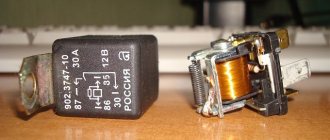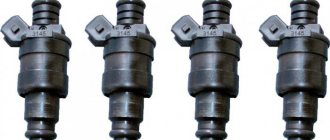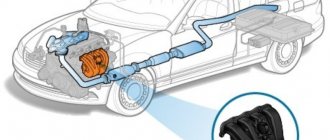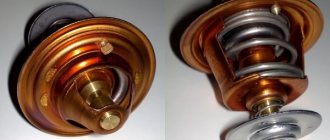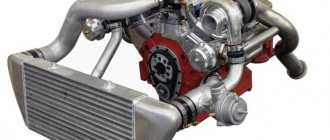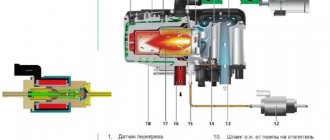Maximum convenience and safety while traveling in a modern car is exactly what most modern automakers strive for. One of the main indicators of a comfortable stay for passengers in a car is the temperature in the cabin. Coolness in the hot summer and warmth in the cold of winter are important factors for a pleasant trip in the car. It is the modern climate control system that is designed to create such favorable conditions.
The essence of the climate control system
The device itself is quite complex and consists of several individual elements that are interconnected. The list of equipment that makes up climate control includes: air conditioning, temperature sensors, interior heater, filter, as well as the system control unit itself. Due to the fact that the climate control system knows the optimal temperature and humidity indicators, sensors analyze their values in the cabin and, depending on the indicators, increase the temperature and humidity or, conversely, reduce it. If the car does not have a climate control system, although most modern car manufacturers offer the installation of this assistant even in models with a basic level of equipment, it can be installed after purchasing the car.
Recirculation mode
When the climate system is turned on, by default it starts operating in automatic mode, which involves distributing the air flow in such a way as to ensure that the temperature is maintained at a given level, separately for the left and right sides of the cabin. If while driving the car the operating parameters of the climate system were set that differed from the original ones, you can return to them by pressing the “AUTO” button (the yellow LED built into the button will light up).
This indicator is changed if for some reason this temperature does not suit the driver or passengers. It should be noted that climate control allows you to set the temperature within 16 - 29.5 degrees Celsius (61 - 86 degrees Fahrenheit), and these values are conditional - depending on external factors, they may shift slightly to one or another side.
This is facilitated by installing a solar radiation sensor. The automatic mode is turned off by pressing any of the control buttons, including the “ECON” button. But this does not mean that the climate control ceases to maintain the specified operating parameters - it is simply considered that new values have been set that will remain the same when the ignition is turned off after the car is stopped.
The main purpose of this mode is to prevent bad-smelling or heavily polluted outside air from entering the cabin. The mode is activated by pressing button 13. The fact that the mode is turned on is indicated by a yellow light built into the button. Typically, this mode is turned on when the car is in a traffic jam (to prevent exhaust gases from entering the cabin) or when driving on a dirt road (to protect against dust from entering the cabin). The recirculation mode will be useful in cool weather, since in this case the cold outside air will not be used.
At very high outside temperatures and low vehicle speeds, the recirculation mode will also be useful, since in this case, instead of hot outside air, cooled cabin air will circulate. Note that when the recirculation mode operates for a long time, the air humidity increases, especially if there are several people in the car, which will lead to fogging of the windows.
Another innovation. When you press button 14, the recirculation mode is turned on/off automatically, for which the system uses the readings of the air quality sensor. Its activation is indicated by a yellow light built into the key. Enabling this mode turns on recirculation in the following cases:
- if the sensor detects the presence of an increased concentration of harmful substances in the air coming from outside. When the level of harmful substances decreases to standard levels, recirculation will be turned off;
- if the windshield defogger mode is turned on. In this case, recirculation will operate for 20 seconds, after which it will turn off.
Note that the air quality sensor is capable of analyzing the air only for the presence of certain harmful substances; it does not react to odors. In the latter case, you need to use button 13 to manually turn on the mode.
What are the main differences between climate control and air conditioning?
The main difference between the two systems is the different design and complexity of the equipment itself. The air conditioner is an independent unit that can function without any additional devices. Climate control is complex in its structure and includes a number of systems, each of which has its own functionality.
The next distinguishing feature between these services is their functionality. The air conditioner can only cool the cabin air, and to increase the temperature the driver must use the heater. Climate control capabilities are much wider. It is able to maintain the appropriate temperature automatically. If necessary, the climate will cool the air in the cabin, and if necessary, heat it. In addition, the climate system has the ability to adjust the temperature regime in such a way that car passengers will not feel cold air flows, and therefore will not be able to get sick.
The control system for these devices is completely different. To activate climate control, it is enough to make the appropriate settings on the electronic unit. But the air conditioner must be constantly turned on and off, which distracts the driver from driving the car.
Differences between simple air conditioning and climate control
Not all motorists, and especially beginners, know the difference between a climate control air conditioner. Some even believe that there is no difference at all, so they do not agree to pay extra. But in fact, the difference is quite noticeable, because the latter option is an improved version of the first. The functionality of climate control is much more diverse, which makes it much more convenient than a simple air cooling device. At the same time, its use not only provides more comfort, but also allows you to take care of the health of those inside the car.
A regular car air conditioner simply cools the air. It works on the principle of a fan. In other words, you press a button, and cold air begins to blow from the hole, which fills the interior. A huge disadvantage is that a conventional cooling device does not have the ability to change the temperature. All that can be done is simply to change the strength of the air flow and its direction. Under such conditions, you can easily catch a cold, or even a more serious illness, especially if a person gets into a car where the air conditioning is working, straight from the street, where the air temperature is 35 degrees. If a passenger or driver falls asleep in a car with a working air conditioner, then he will be provided with sick leave .
To reduce risks, some time ago engineers developed a new device for cooling the vehicle interior, which is called climate control.
. Its operation differs significantly from the operation of a conventional air conditioner, since it not only cools the air, but also controls the temperature. That is, the temperature in the car will be exactly as the person wants, no lower. For this purpose, an automatic system is provided here, with which you can set the optimal temperature. In addition, climate control provides manual control mode.
What types of climate control are there?
Since this device is a collection of various built-in systems and services, it has quite noticeable differences in its capabilities. Various climate control installations differ depending on the number of zones served, power, and whether it is equipped with various functionality.
As a rule, modern manufacturers produce climate control units with the ability to service from one to four zones in the car. The simplest type is a single-zone climate. This installation regulates the temperature and humidity of the air flow directly near the driver and front passenger. Dual-zone allows you to make separate settings for the driver's zone and for the front passenger. The system, divided into 3 zones, can additionally regulate the temperature for rear row passengers. Well, the most comfortable and functional is the four-zone climate control system.
Climate control device in a car
It’s not for nothing that the climate control system is called a “system”. It really has a complex structure and includes several mechanisms:
- thermal sensors - determine the air temperature in different parts of the cabin;
- humidity meter - installed only in the latest models, determines the level of humidity inside the car;
- software controller - data from all sensors is received here, analyzed, and then commands are sent to turn on or off the necessary mechanisms;
- air conditioning - turns on at elevated temperature and humidity;
- fan - necessary for circulating and mixing air in the cabin;
- oven - turns on at low temperature, works due to antifreeze heated in the radiator;
- electric furnace valves - block the flow of warm air when it is not required;
- air intakes and air outlets - are responsible for the effective distribution of air flows, directing them where needed.
In winter, the climate control system operates as follows:
- The driver sets a comfortable air temperature and turns on “auto mode”.
- Sensors determine temperature and humidity, sending the received data to the software controller.
- The controller analyzes this data, comparing it with the values set by the driver.
- If the cabin is warmer than necessary, the air conditioning starts. If it is colder, the coolant from the engine is supplied to the radiator and the electric valves of the furnace open.
- The higher the difference between the set and actual values, the stronger or weaker the fan will work.
- As soon as the temperature in the cabin reaches the specified value, the system will turn on the maintenance mode, reducing the blowing speed and heating level.
Important! The above step-by-step algorithm may differ depending on the climate control model and its functions. The newest systems have the ability to set additional settings
For example, set different temperatures in separate areas of the cabin.
How to use the device
Each type of car is individual and differs in the level of equipment. Therefore, climate control controls may differ depending on how expensive and famous the car is. As a rule, today's models are equipped with a classic control system, consisting of buttons and rotary selectors, or a touch control system, where all settings are made using the built-in functionality access display.
In general, the system is activated by pressing the On/Off key. To turn on the air conditioner, you will need to press A/c. Temperature adjustment is carried out using the rotary selector or the corresponding value is set on the touch display. To be able to automatically maintain the set parameters, the manufacturer provides an Auto button. Separately, using the rotary selector or touch settings, you can specify the direction of airflow on passengers or windows.
In order for the installation to operate for as long as possible without any problems, manufacturers recommend annual maintenance, determining the tightness of the system and eliminating emerging problems. If necessary, service specialists refill the system with a special refrigerant.
What are the pros and cons of air conditioning
Like any mechanism, this system has a number of advantages and disadvantages. The main advantages of climate control include:
- favorable and comfortable conditions for traveling any distance;
- the ability to set automatic system operating parameters and not be distracted by adjusting and turning off the device;
- a lot of adjustment possibilities;
- ease of operation.
The disadvantages of having a climate control system in a car include:
- the rise in price of the car itself, equipped with such an assistant;
- the rather expensive cost of maintaining and repairing the system in the event of a breakdown;
- increased vehicle fuel consumption when the service is turned on for a long time;
- the need to contact a specialized service in case of failure.
How to use climate control in winter
At low temperatures, the car's climate control equipment works mainly to heat the outside air. At negative parameters, its humidity is relatively low and the stove is quite enough.
Turning off the air conditioner in this case will not affect the efficiency of the climate control installation as a whole.
The situation is more complicated when the temperature is near zero, with high humidity or rain and snow.
In this case, the windows and windshield may fog up; switching the system to automatic mode will easily solve this problem. The installation, if necessary, uses an air conditioner to remove excess moisture from the outside air.
When choosing the operating mode of the system, you should be guided by the recommendations of the car manufacturer and your own operating experience.
A detailed answer to the question: what is climate control in a car and what are its main advantages and disadvantages can be summarized in a few phrases.
The installation is necessary to create comfortable conditions for humans in the car interior with their automatic regulation.
A modern car with climate control can make both a short trip and a long trip as pleasant as possible.
May be of interest:
Compare the cost of MTPL for your car
Scanner for self-diagnosis of a car
Choose a DVR: an indispensable gadget for the driver
Some drivers prefer a DVR in the form of a mirror
How to perform self-diagnosis and determine the cause of the breakdown
Each manufacturer, when releasing this system, provides the ability to determine by the error codes issued what exactly happened to the climate control. Of course, all developers provide the diagnostic procedure differently. But still, the most universal system that works on most air conditioning systems is the following:
- the driver must turn on the car's ignition and press the on/off button on the climate control control unit;
- if the system turns on and all the unit indicators light up, then you can proceed to the next stage;
- Here it is necessary to check the integrity of the electrical circuit. To do this, you need to adjust the temperature a degree higher than it was set and expect. The number 2 should light up on the screen of the control unit, followed by 0. If this does not happen, an error code will be displayed, which will explain the cause of the malfunction;
- Next, the damper adjustment is checked. To do this, you also need to increase the set temperature by 1 degree and wait for code 30 to appear, which will mean that everything is in order with these elements. Otherwise, the climate control reason code will again be indicated.
In order for the system to last as long as possible, it is necessary to regularly clean the interior ventilation and also replace the filter.
In general, the presence of climate control in a car allows you to organize a comfortable temperature for both the driver and passengers in a matter of minutes. It is much more convenient and modern than a standard air conditioner, but requires appropriate care and maintenance. Author: Konstantin Starchenko
